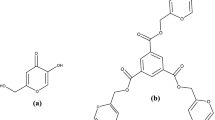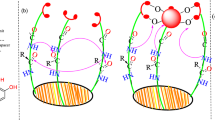Abstract
A new tripodal siderophore-mimic hexadentate chelator, N,N’,N’’-(((1R,3R)-cyclohexane-1,3,5-triyl)tris(methylene))tris(1-hydroxy-6-oxo-1,6-dihydropyridine-2 carboxamide), (TMACH-1,2-HOPO) containing three 1,2-hydroxypyridinone units attached to a cyclohexane ring through amide linkage at 1,3 and 5 positions have been designed, synthesized, and characterized by FT-IR, 1H NMR, 13C NMR, ESI-MS, and electronic spectroscopy. The solution thermodynamics and photophysical properties of the ligand and its metal complexes (M = La3+, Gd3+, and Lu3+) were investigated experimentally and theoretically in an aqueous medium. The pKa values for the ligand were found to be 8.32, 6.86, and 5.45. In an aqueous solution, the ligand formed complexes of the type MLH3, MLH2, MLH, and Mion. Additionally, it formed three hydrolyzed species, MLH− 1, MLH− 2, and MLH− 3 at a higher pH. DFT studies were performed, which support the experimental results. The nature of bonding between the lanthanide ions and the ligand was explained by NBO, Morokuma Ziegler energy decomposition analysis (ETS-NOCV).















Similar content being viewed by others
References
Caro, P.: Rare Earths. Editorial Complutense, Newyork (1998)
Buss, J.L., Neuzil, J., Ponka, P.: Oxidative stress mediates toxicity of pyridoxal isonicotinoyl hydrazone analogs. Arch. Biochem. Biophys. 421, 1–9 (2004). https://doi.org/10.1016/j.abb.2003.09.044
Bruice, T.C., Tsubouchi, A., Dempcy, R.O., Olson, L.P.: One- and two-metal ion catalysis of the hydrolysis of adenosine 3’-alkyl phosphate esters. Models for one- and two-metal ion catalysis of RNA hydrolysis. J. Am. Chem. Soc. 118, 9867–9875 (1996). https://doi.org/10.1021/ja9607300
Oh, S.J., Choi, Y.S., Hwangbo, S., Bae, S.C., Ku, J.K., Park, J.W.: Structure and phosphodiesterase activity of Bis-Tris coordinated lanthanide(III) complexes. Chem. Commun. 20, 2189–2190 (1998). https://doi.org/10.1039/a806021e
Santos, M.A., Marques, S.M., Chaves, S.: Hydroxypyridinones as privileged chelating structures for the design of medicinal drugs. Coord. Chem. Rev. 256, 240–259 (2012). https://doi.org/10.1016/j.ccr.2011.08.008
Persy, V.P., Behets, G.J., Bervoets, A.R., De Broe, M.E., D’Haese, P.C.: Lanthanum: A safe phosphate binder. Semin. Dial 19, 195–199 (2006). https://doi.org/10.1111/j.1525-139X.2006.00169.x
Persy, V.P., Behets, G.J., De Broe, M.E., D’Haese, P.C.: Management of hyperphosphatemia in patients with end-stage renal disease: Focus on lanthanum carbonate. Int. J. Nephrol. Renovasc Dis. 2, 1–8 (2009). https://doi.org/10.2147/ijnrd.s5007
Rasaneh, S., Rajabi, H., Babaei, M.H., Daha, F.J., Salouti, M.: Radiolabeling of trastuzumab with 177Lu via DOTA, a new radiopharmaceutical for radioimmunotherapy of breast cancer. Nucl. Med. Biol. 36, 363–369 (2009). https://doi.org/10.1016/j.nucmedbio.2009.01.015
Datta, A., Raymond, K.N.: Gd-hydroxypyridinone (HOPO)-based high-relaxivity magnetic resonance imaging (MRI) contrast agents. Acc. Chem. Res. 42, 938–947 (2009). https://doi.org/10.1021/ar800250h
Jocher, C.J., Moore, E.G., Xu, J., Avedano, S., Botta, M., Aime, S., Raymond, K.N.: 1,2-Hydroxypyridonates as contrast agents for magnetic resonance imaging: TREN-1,2-HOPO. Inorg. Chem. 46, 9182–9191 (2007). https://doi.org/10.1021/ic700985j
Wei, C., Yao, X., Sun, B., Cai, Z., Zhao, Z., Chen, M., Wei, H., Liu, Z., Bian, Z., Huang, C.: Evaporable luminescent lanthanide complexes based on novel tridentate ligand. J. Rare Earths. 35, 7–14 (2017). https://doi.org/10.1016/S1002-0721(16)60166-7
Moore, E.G., Samuel, A.P.S., Raymond, K.N.: From antenna to assay: Lessons learned in lanthanide luminescence. Acc. Chem. Res. 42, 542–552 (2009). https://doi.org/10.1021/ar800211j
He, M., Fan, M., Peng, Z., Wang, G.: An overview of hydroxypyranone and hydroxypyridinone as privileged scaffolds for novel drug discovery. Eur. J. Med. Chem. 221, 113546 (2021). https://doi.org/10.1016/j.ejmech.2021.113546
Chaves, S., Piemontese, L., Hiremathad, A., Santos, M.A.: Hydroxypyridinone derivatives: A fascinating class of chelators with therapeutic applications - an update. Curr. Med. Chem. 25, 97–112 (2017). https://doi.org/10.2174/0929867324666170330092304
Liu, Z.D., Hider, R.C.: Design of clinically useful iron(III)-selective chelators, Med. Res. Rev. 22, 26–64 (2002). https://doi.org/10.1002/med.1027
Tedeschi, C., Azéma, J., Gornitzka, H., Tisnès, P., Picard, C.: A solid-state study of eight-coordinate lanthanide(III) complexes (Ln = Eu, Gd, Tb, Dy) with 1-hydroxy-2-pyridinone. Dalt. Trans. 9, 1738–1745 (2003). https://doi.org/10.1039/b300159h
Yantasee, W., Fryxell, G.E., Lin, Y., Wu, H., Raymond, K.N., Xu, J.: Hydroxypyridinone functionalized self-assembled monolayers on nanoporous silica for sequestering lanthanide cations. J. Nanosci. Nanotechnol. 5, 527–529 (2005). https://doi.org/10.1166/jnn.2005.096
Sturzbecher-Hoehne, M., Choi, T.A., Abergel, R.J.: Hydroxypyridinonate complex stability of group (IV) metals and tetravalent f-block elements: The key to the next generation of chelating agents for radiopharmaceuticals. Inorg. Chem. 54, 3462–3468 (2015). https://doi.org/10.1021/acs.inorgchem.5b00033
Abergel, R.J., Durbin, P.W., Kullgren, B., Ebbe, S.N., Xu, J., Chang, P.Y., Bunin, D.I., Blakely, E.A., Bjornstad, K.A., Rosen, C.J., Shuh, D.K., Raymond, K.N.: Biomimetic actinide chelators: An update on the preclinical development of the orally active hydroxypyridonate decorporation agents 3,4,3-LI(1,2-HOPO) and 5-LIO(ME-3,2-HOPO). Health Phys. 99, 401–407 (2010). https://doi.org/10.1097/HP.0b013e3181c21273
Workman, D.G., Hunter, M., Wang, S., Brandel, J., Hubscher, V., Dover, L.G., Tétard, D.: The influence of linkages between 1-hydroxy-2(1H)-pyridinone coordinating groups and a tris(2-aminoethyl)amine core in a novel series of synthetic hexadentate iron(III) chelators on antimicrobial activity. Bioorg. Chem. 95, 103465 (2020). https://doi.org/10.1016/j.bioorg.2019.103465
Dash, D., Baral, M., Kanungo, B.K.: Synthesis of a new tetradentate chelator with 1-Hydoroxy-2(1H)-pyridinone (HOPO) as chelating unit: Interaction with Fe (III), solution thermodynamics and DFT studies. J. Mol. Struct. 1222, 128796 (2020). https://doi.org/10.1016/j.molstruc.2020.128796
Silverstein, R.W., Bassler, G.C.: Spectrometric identification of organic compounds. J. Chem. Educ. 39, 546–553 (1962). https://doi.org/10.1021/ed039p546
Pretsch, E., Buhlmann, P., Badertscher, M.: Tables of Spectral Data. Springer, Berlin (2009). https://doi.org/10.1007/978-3-540-93810-1
Moore, E.G., Xu, J., Dodani, S.C., Jocher, C.J., Daléo, A., Seitz, M., Raymond, K.N.: 1-methyl-3-hydroxy-pyridin-2-one complexes of near infra-red emitting lanthanides: Efficient sensitization of Yb(III) and nd(III) in aqueous solution. Inorg. Chem. 49, 4156–4166 (2010). https://doi.org/10.1021/ic902219t
D’Aléo, A., Xu, J., Moore, E.G., Jocher, C.J., Raymond, K.N.: Aryl-bridged 1-hydroxypyridin-2-one: Sensitizer ligands for Eu(III). Inorg. Chem. 47, 6109–6111 (2008). https://doi.org/10.1021/ic8003189
Qiu, D.H., Huang, Z.L., Zhou, T., Shen, C., Hider, R.C.: In vitro inhibition of bacterial growth by iron chelators. FEMS Microbiol. Lett. 314, 107–111 (2011). https://doi.org/10.1111/j.1574-6968.2010.02153.x
Zhou, Y.J., Zhang, M.X., Hider, R.C., Zhou, T.: In vitro antimicrobial activity of hydroxypyridinone hexadentate-based dendrimeric chelators alone and in combination with norfloxacin. FEMS Microbiol. Lett. 355, 124–130 (2014). https://doi.org/10.1111/1574-6968.12465
Dash, D., Baral, M., Kanungo, B.K.: Development of a Flexible Tripodal Hydroxypyridinone Ligand with Cyclohexane Framework: Complexation, Solution Thermodynamics, Spectroscopic and DFT Studies. ChemistrySelect 6, 12165–12181 (2021). https://doi.org/10.1002/slct.202102962
Chaves, S., Mendonça, A.C., Marques, S.M., Prata, M.I., Santos, A.C., Martins, A.F., Geraldes, C.F.G.C., Santos, M.A.: A gallium complex with a new tripodal tris-hydroxypyridinone for potential nuclear diagnostic imaging: Solution and in vivo studies of 67Ga- labeled species. J. Inorg. Biochem. 105, 31–38 (2011). https://doi.org/10.1016/j.**orgbio.2010.09.012
Golcu, A., Tumer, M., Demirelli, H., Wheatley, R.A.: Cd(II) and Cu(II) complexes of polydentate Schiff base ligands: Synthesis, characterization, properties and biological activity. Inorganica Chim. Acta. 358, 1785–1797 (2005). https://doi.org/10.1016/j.ica.2004.11.026
Werner, F.J., Kozhukh, J., Botta, M., Moore, E.G., Avedano, S., Aime, S., Raymond, K.N.: 1,2-hydroxypyridonate/terephthalamide complexes of gadolinium(lll): Synthesis, stability, relaxivity, and water exchange properties. Inorg. Chem. 48(2009), 277–286 (1995). https://doi.org/10.1021/ic801730u
Mcdonald, F.C., Applefield, R.C., Halkides, C.J., Reibenspies, J.H., Hancock, R.D.: A thermodynamic and crystallographic study of complexes of the highly preorganized ligand 8-hydroxyquinoline-2-carboxylic acid. Inorganica Chimica Acta 361(7), 1937–1946 (2008). https://doi.org/10.1016/j.ica.2007.10.004
Hasegawa, M., Ohmagari, H., Tanaka, H., Machida, K.: Luminescence of lanthanide complexes: From fundamental to prospective approaches related to water- and molecular-stimuli. J. Photochem. Photobiol C Photochem. Rev. 50, 100484 (2022). https://doi.org/10.1016/j.jphotochemrev.2022.100484
Baerends, A.L.Y.E.J., Ziegler, T., Atkins, A.J., Autschbach, J., Baseggio, O., Bashford, D., Bérces, A., Bickelhaupt, F.M., Bo, C., Boerrigter, P.M., Cavallo, L., Daul, C., Chong, D.P., Chulhai, D.V., Deng, L., Dickson, R.M., Dieterich, J.M., Ellis, D.E., van Faassen, M., Fan, L.: ADF2017, ADF2017. (2017). htttp://www.scm.com
Grabowski, J.W., Fleming, D.G., Vogt, E.W.: The (p,d) reaction at intermediate beam energies. I. plane-wave born approximation (semi-analytical) calculations. Can. J. Phys. 54, 870–888 (1976). https://doi.org/10.1139/p76-103
Geerlings, P., De Proft, F., Langenaeker, W.: Conceptual density functional theory. Chem. Rev. 103, 1793–1873 (2003). https://doi.org/10.1021/cr990029p
Govindarajan, M., Karabacak, M., Periandy, S., Tanuja, D.: Spectroscopic (FT-IR, FT-Raman, UV and NMR) investigation and NLO, HOMO-LUMO, NBO analysis of organic 2,4,5-trichloroaniline. Spectrochim. Acta - Part A Mol. Biomol. Spectrosc. 97, 231–245 (2012). https://doi.org/10.1016/j.saa.2012.06.014
Pearson, R.G.: Chemical hardness and density functional theory. J. Chem. Sci. 117, 369–377 (2005). https://doi.org/10.1007/BF02708340
Pearson, R.G.: Recent advances in the concept of hard and soft acids and bases. J. Chem. Educ. 64, 561–567 (1987). https://doi.org/10.1021/ed064p561
Pearson, R.G.: Absolute Electronegativity and Absolute hardness of Lewis acids and bases. J. Am. Chem. Soc. 107, 6801–6806 (1985). https://doi.org/10.1021/ja00310a009
Parr, R.G., Pearson, R.G.: Absolute hardness: Companion parameter to Absolute Electronegativity. J. Am. Chem. Soc. 105, 7512–7516 (1983). https://doi.org/10.1021/ja00364a005
Choudhary, V.K., Bhatt, A.K., Dash, D., Sharma, N.: DFT calculations on molecular structures, HOMO–LUMO study, reactivity descriptors and spectral analyses of newly synthesized diorganotin(IV) 2-chloridophenylacetohydroxamate complexes. J. Comput. Chem. 40, 2354–2363 (2019). https://doi.org/10.1002/jcc.26012
Helm, L., Merbach, A.E.: Water exchange on metal ions: Experiments and simulations. Coord. Chem. Rev. 187, 151–181 (1999). https://doi.org/10.1016/S0010-8545(99)90232-1
Cotton, S.A.: Establishing coordination numbers for the lanthanides in simple complexes. Comptes Rendus Chim. 8, 129–145 (2005). https://doi.org/10.1016/j.crci.2004.07.002
Konings, M.S., Raymond, K.N., Dow, W.C., Love, D.B., Quay, S.C., Rocklage, S.M.: Gadolinium Complexation by a new DTPA-Amide ligand. Amide Oxygen Coordination. Inorg. Chem. 29, 1488–1491 (1990). https://doi.org/10.1021/ic00333a009
Hirshfeld, F.L.: Bonded-atom fragments for describing molecular charge densities. Theor. Chim. Acta. 44, 129–138 (1977). https://doi.org/10.1007/BF00549096
Fonseca Guerra, C., Handgraaf, J.W., Baerends, E.J., Bickelhaupt, F.M.: Voronoi Deformation Density (VDD) charges: Assessment of the Mulliken, Bader, Hirshfeld, Weinhold, and VDD methods for Charge Analysis. J. Comput. Chem. 25, 189–210 (2004). https://doi.org/10.1002/jcc.10351
Graphical, Abstract: Angew. Chem. Int. Ed. 35/ Angew. Chemie Int. Ed. 42 (2003) 4112–4120. (2003). https://doi.org/10.1002/anie.200390573
Verma, R., Baral, M., Kanungo, B.K.: Computational and experimental studies on the effect of conformational flexibility on bonding and photophysics of a triaza-macrocycle tripod. J. Incl. Phenom. Macrocycl. Chem. 101, 253–273 (2021). https://doi.org/10.1007/s10847-021-01084-4
Funding
One of the author (Dibyajit Dash) is grateful to the management of Sant Longowal Institute of Engineering and Technology, Longowal, for financial support.
Author information
Authors and Affiliations
Contributions
Dibyajit Dash: Experimental work, manuscript preparation, Shalini Singh: Verification and validation of Data, Minati Baral and B K Kanungo: Concept, Supervision and Editing.
Corresponding author
Ethics declarations
Conflict of interest
The authors state that they will have no competing commercial interests or personal relationships that might have influenced the research presented in this publication.
Additional information
Publisher’s Note
Springer Nature remains neutral with regard to jurisdictional claims in published maps and institutional affiliations.
Supplementary Information
Below is the link to the electronic supplementary material.
Details of experimental section, HRMS data, IR, 1H NMR, 13C NMR, spectrophotometric titration curves of ligand with lanthanide ions and the energy level diagrams of LH3 and its deprotonated species are given in Figure S1, Figure S2, Figure S3, Figure S4, Figure S5 and Figure S6 respectively. The calculated and experimentally obtained chemical shifts, stretching frequencies are presented in Table S1, whereas the DFT simulated thermodynamic parameters, bond energy, HOMO and LUMO energy of neutral and deprotonated ligand species are available in Table S2 of the Supporting information.
Rights and permissions
Springer Nature or its licensor (e.g. a society or other partner) holds exclusive rights to this article under a publishing agreement with the author(s) or other rightsholder(s); author self-archiving of the accepted manuscript version of this article is solely governed by the terms of such publishing agreement and applicable law.
About this article
Cite this article
Dash, D., Singh, S., Baral, M. et al. TMACH-1,2-HOPO, a versatile tripodal metal chelator: complexation, solution thermodynamics, spectroscopic and DFT studies. J Incl Phenom Macrocycl Chem 104, 109–127 (2024). https://doi.org/10.1007/s10847-024-01221-9
Received:
Accepted:
Published:
Issue Date:
DOI: https://doi.org/10.1007/s10847-024-01221-9




